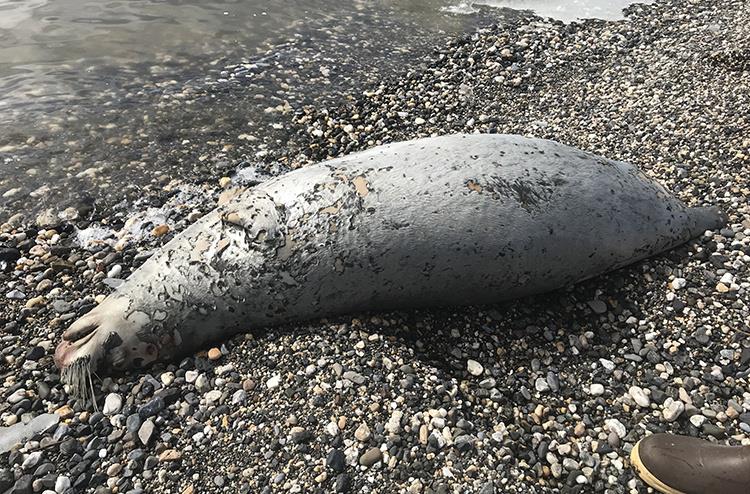
NOAA Fisheries declares unusual mortality event due to elevated strandings of Ice Seals in Arctic
by NOAA Fisheries 19 Sep 2019 05:12 UTC

A dead seal found on a beach near Kotzebue, Alaska © NPS / Raime Fronstin
NOAA is declaring an Unusual Mortality Event (UME) for bearded, ringed, and spotted seals in the Bering and Chukchi seas. From June 1, 2018 to present there have been reports of 282 dead seals, with 119 stranded seals in 2018 and 163 in 2019. The increase in ice seal mortality is nearly 5 times the average number of reported strandings, which is about 29 seals annually.
Since June 1, 2018, there have been 85 bearded, 66 ringed, 40 spotted, and 91 unidentified stranded ice seals. The UME includes:
Reports of stranded seals primarily occurred from June to September. All age classes of ice seals were reported. A subset of ice seals were sampled for harmful algal blooms and health parameters. When possible, skin was collected from stranded seals to help determine the species. Results are pending.
Why Declare an Unusual Mortality Event?
The Marine Mammal Protection Act defines an Unusual Mortality Event as a stranding event that is unexpected, involves a significant die-off, and demands an immediate response. NOAA Fisheries assessed whether the increased ice seal mortalities met at least one of seven criteria required for a UME.
We concluded that the ice seal die-off met the first criterion: A marked increase in the magnitude or a marked change in the nature of morbidity, mortality, or strandings when compared with prior records.
Declaration of a UME will bring more focus, expertise, and resources to help the investigation. The public may use Pay.gov to donate to the Marine Mammal UME Contingency Fund for this or other UMEs and help cover costs incurred by the Alaska Marine Mammal Stranding Network.
Ice Seals: Essential Food and Cultural Resource for Alaska Natives
Alaska Natives living along the coast of Alaska, specifically the Beaufort, Chukchi, and Bering seas, and Bristol Bay, are highly reliant on ice seals to maintain their nutrition and subsistence culture. Hunting, processing, and using seals is an important part of Alaska Native culture and heritage. Seals are a source of food, and their skins are used for clothes, boats, and handicrafts.
Due to the implications to marine mammal health and food safety, marine mammal strandings are a major concern to Alaska Native hunters and communities.
Coastal community members and subsistence hunters are often the first to discover unusual wildlife events. They provide valuable information for monitoring the health of wildlife populations.
Local communities provided valuable information to document sick and dead ice seals, leading to this UME declaration. Collaboration and communication with subsistence user groups, community organizations, and Alaska Native organizations result in a more efficient and comprehensive response to unusual wildlife events.
How to Report a Dead Seal
The public should report dead, injured, or sick marine mammals by calling NOAA's Alaska Marine Mammal Stranding Network at (877) 925-7773, or contact local wildlife authorities.